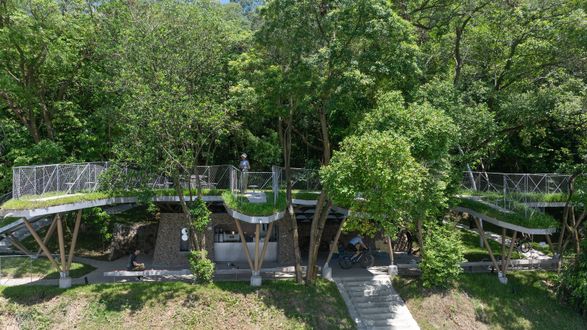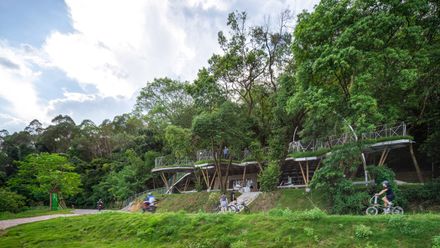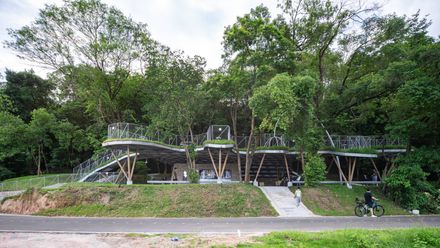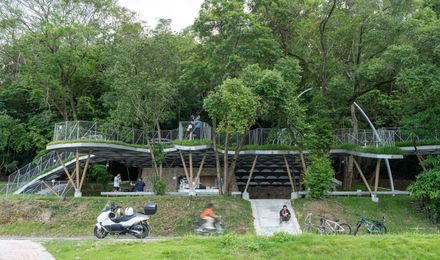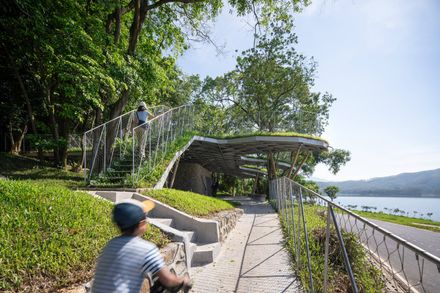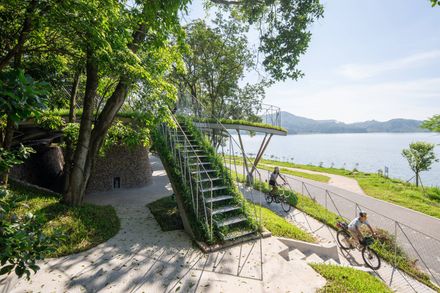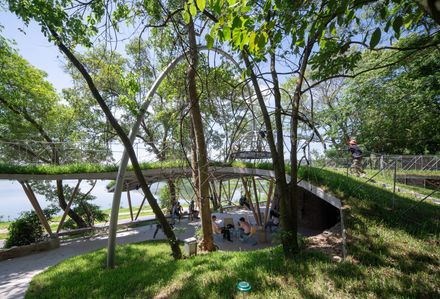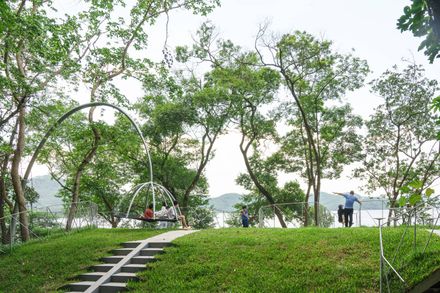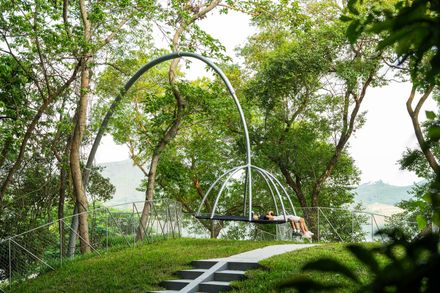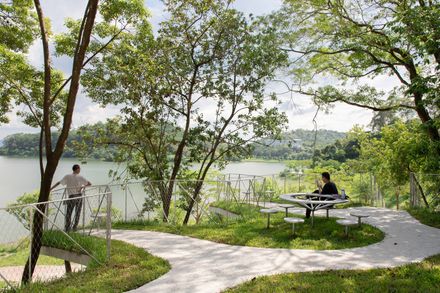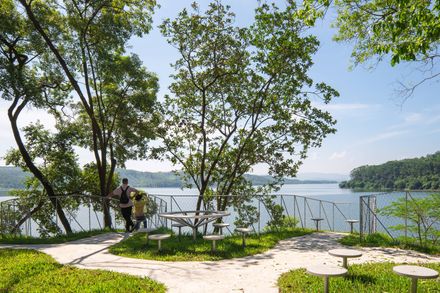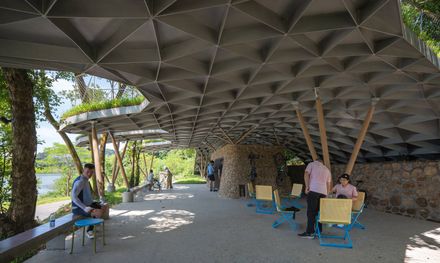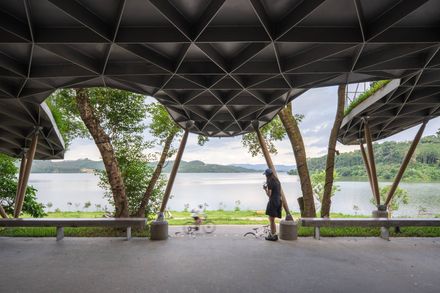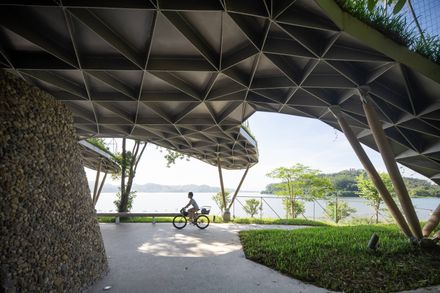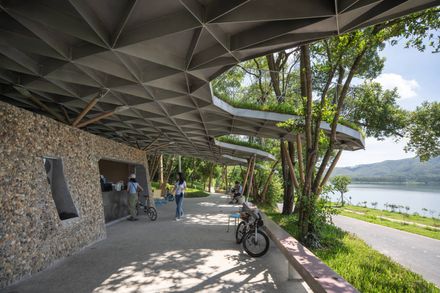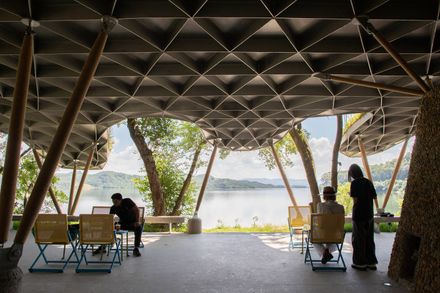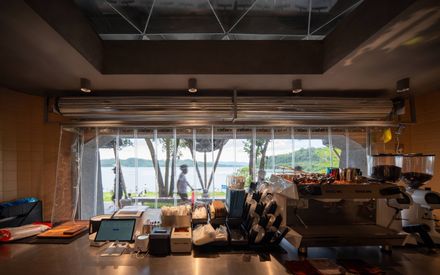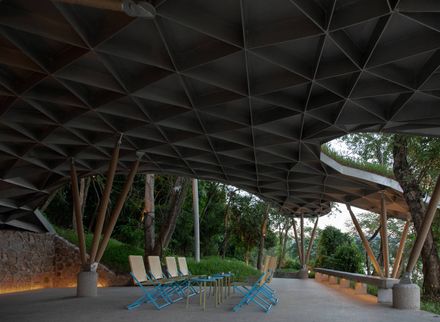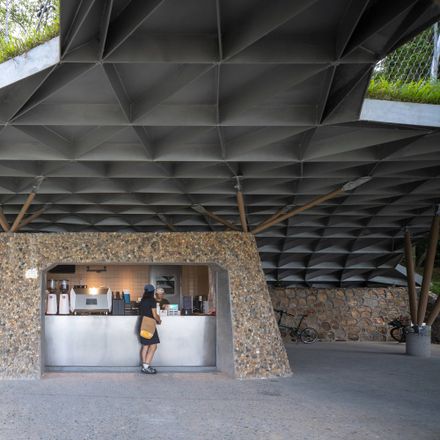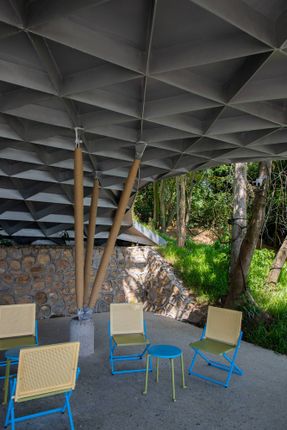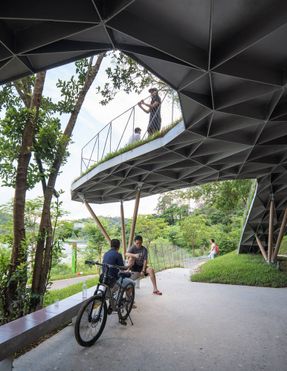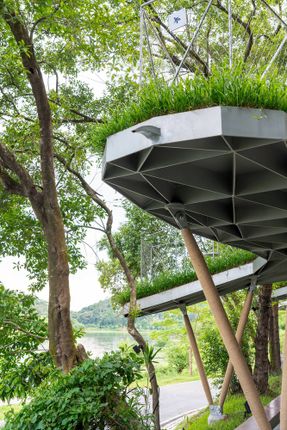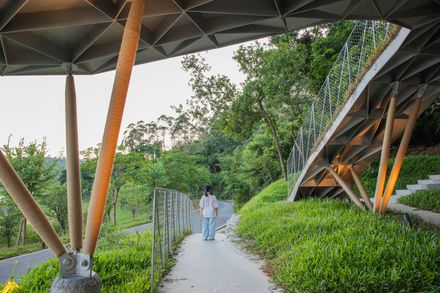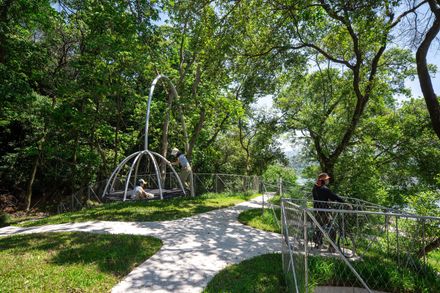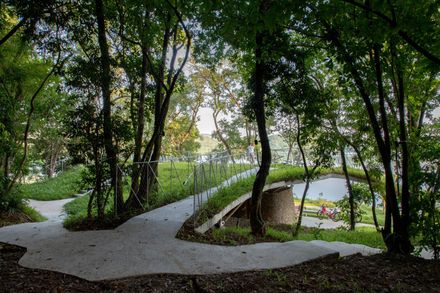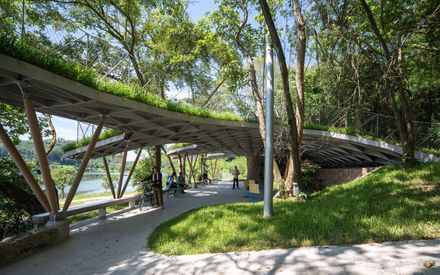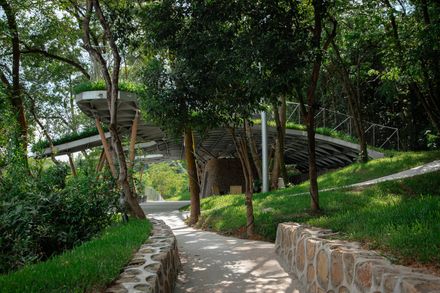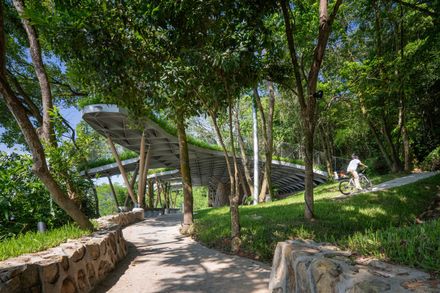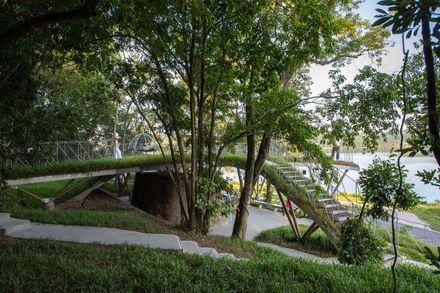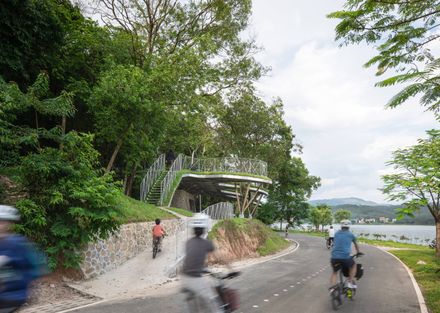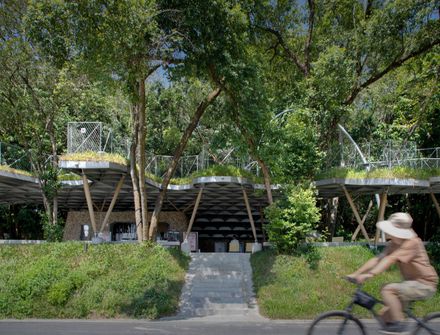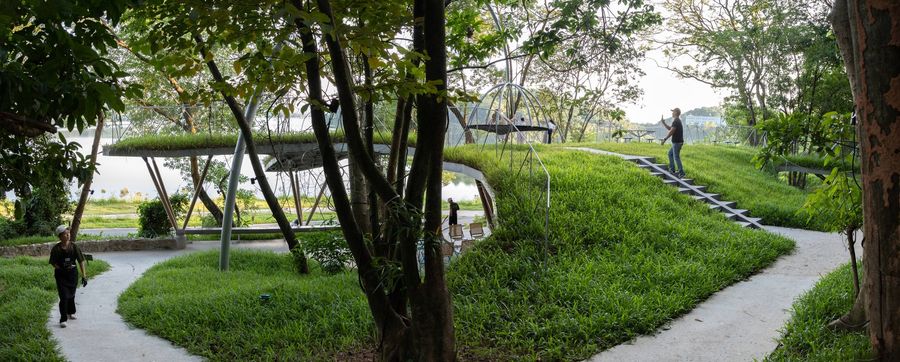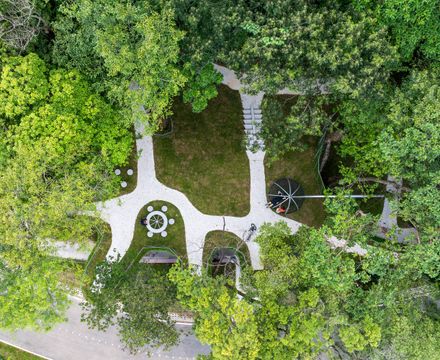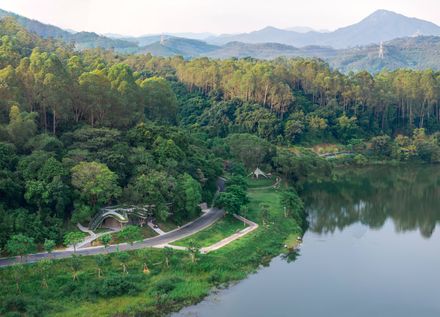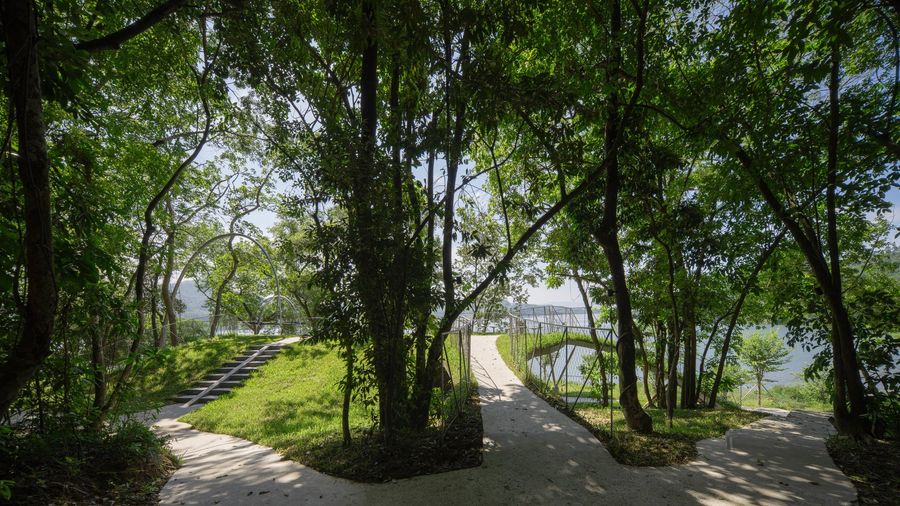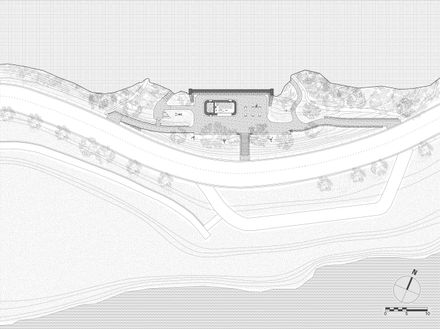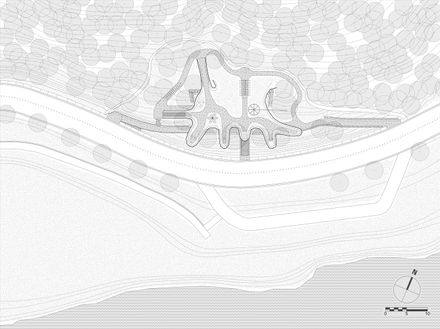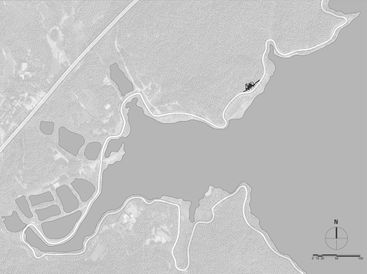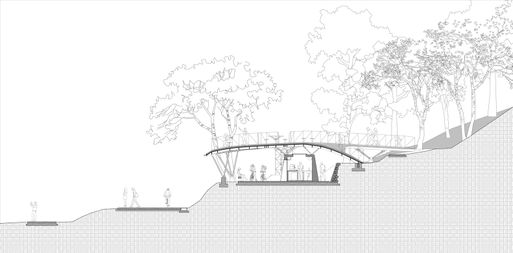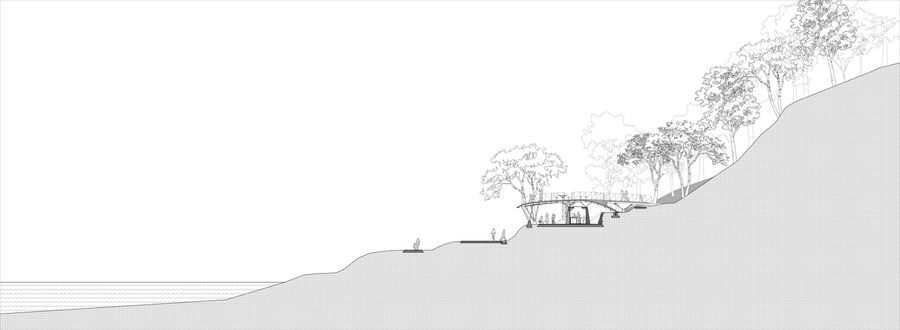Five-Finger Pavilion
ARCHITECTS
Yxdesigners
PROJECT MANAGEMENT
Shanghai Fengyuzhu Culture & Tech Co., Ltd
CONSTRUCTION
Zz Architectural Design&consulting
LIGHTING DESIGN
Ada Lighting Design Consultants
CONSTRUCTION MANAGER
Hao Yancun, Huang Tao, Ren Yingping, Huang Yun
DESIGN TEAM
Lu Jiahong, Xue Yiwen, Peng Tan, Mo Linghuizi
CONSTRUCTION DESIGN TEAM
Chen Zejiu, Huang Tao
LIGHTING DESIGN TEAM
Sean Hung, Jinyi Liu, Mandy Zhou
CONSTRUCTION DESIGN
Shanghai Tongcheng Building Technology & Engineering
PHOTOGRAPHS
ZC Photography Studio, YXDesigners
AREA
200 m²
YEAR
2025
LOCATION
Huizhou, China
CATEGORY
Pavilion
BUILDING A STATION FOR "BOLUO SEA"
The Xiangang Reservoir at the foot of Luofu Mountain in Boluo County, Huizhou, is surrounded by lush mountains and forests.
Its vast water surface has earned it the nickname "Boluo Sea." The 27-kilometer loop road around the lake is designated for non-motorized vehicles only, and is typically bustling with cyclists, motorcyclists, and pedestrians.
However, a lack of existing stations means there are few places to stop and rest.
The Phoenix Valley Pavilion is situated on a wooded slope beside the loop road, facing the reservoir across the road. The original site consisted of two man-made terraces carved into the slope.
On the lower terrace stood two lightweight steel simple houses, connected to the loop road by a flight of steps accounting for a two-meter height difference.
The upper terrace had a roughly excavated drainage ditch for channeling mountain floodwater. Dense woods partially obscured both terraces.
Going with the Flow: A Green Palm Reaching Towards the Water — In retrospect, the entire design process was one of "顺势而为" (shun shi er wei, or going with the flow).
To preserve all trees and minimize earthworks, we decided to continue using the existing two terraces, simply replacing the simple houses on the lower terrace with the new Phoenix Valley Pavilion.
The ground hardening for the previous structures had damaged the green patch of the mountain forest, so we sought to repair it through roof planting.
The greened roof appears to grow naturally from the land, seamlessly connecting with the forest greenery of the upper terrace, like a green palm flowing from the mountain slope towards the water.
The dense woods blocked the Phoenix Valley Pavilion's view of the lake and also obscured the pavilion from the loop road.
Our solution was to let the five "fingers" of the palm extend through gaps in the trees towards the water, forming viewing platforms at different angles, while also making the pavilion more noticeable to cyclists.
The palm's "arch" provides clear height for the small building beneath, while the drooping "fingertips" avoid low-hanging branches.
Typically, designs that avoid trees rely heavily on precise topographic surveys of the trees. However, as the site is within a military exercise area, we anticipated that satellite surveying would be inaccurate.
Therefore, we designed the "palm" as a flexible, hand-drawn-like series of short zigzags. This allowed for easy on-site adjustments during construction if the survey data proved inaccurate, without significantly impacting the construction schedule.
It was later confirmed that significant discrepancies did exist even after two surveys, necessitating major design modifications during construction.
The Phoenix Valley Pavilion is defined as a bicycle station; all paths are rideable or at least easy to push a bike along. People can ride their bikes onto the roof and wander up and down, in and out through the woods.
Since the existing steps were inconvenient for cycling, we built two new bicycle paths, left and right from the loop road, weaving through the forest to connect to the terraces.
In the Chinese perspective of viewing landscape, "势" (shi, or potential/energy) is an important concept, seen as the筋骨 (jin gu, sinews and bones) and经脉 (jing mai, meridians) of nature, containing the direction, spirit, and inherent vitality of mountains and rivers.
Therefore, "顺势而为" or "顺其自然" (shun qi zi ran, let things take their own course) not only describes the design process but also the symbiotic relationship between the Phoenix Valley Pavilion and nature.
It is about repairing rather than destroying, continuing rather than interrupting, using the five fingers as a green canopy to guide the mountain forest as it flows towards the water.
A WAYSIDE TEA SHED WHERE YOU CAN GO UPSTAIRS TO VIEW THE "SEA"
The pavilion functions like a traditional wayside tea shed, welcoming passersby to sit and have a coffee. The small building under the canopy houses the coffee operation area and restrooms.
This small building is "hollowed out" with five openings and five niches: a coffee service window, a door, a skylight, an outdoor sink, and two adjacent niches—one for a sculpture and one for the air conditioner outdoor unit. There are hooks on the wall for cyclists to hang their bicycles. It is a small house like a Swiss Army knife.
From the loop road, taking the new bicycle path through the woods leads to the lower terrace and the small building. After buying coffee, one can ride up to the roof and gaze at the reservoir from the "fingertips" of the green palm.
The art installation "Tentacle" takes root on the lower platform, extending like a fishing rod up above the roof. Visitors sitting on it can sway with the "Tentacle," interacting with the grass, trees, and sky in a playful manner.
Thanks to the shade from the trees and the lake breeze, even in the June heat of Guangdong, the green palm is a bearable place to be. Sitting on the "Tentacle," looking at the merging hues of lake and sky, is so comfortable it's easy to become drowsy.
If it rains or more sun protection is needed, one can sit under the canopy, where the earth-covered roof keeps the space cool and pleasant.
Under the canopy are our custom-designed folding chairs and stacking tables, spacious, comfortable, and easy to store, colored using the official theme colors of the "Sixteen Pleasures."
There are also long benches paved with pink tiles, adopting folk wisdom for cool and comfortable seating.
RESPONDING TO MULTIPLE TRADITIONS
Fancifully imagining that South China tigers might still roam these remote forests, perhaps building a "虎皮墙" (hu pi qiang, tiger-skin wall – a type of rustic rubblestone wall) fits the theme of a forest station...
The tiger-skin wall at the Phoenix Valley Pavilion is not as elaborate as traditional palace walls, nor is it like the quickly built retaining walls of recent decades that have the form but not the spirit – where the drawn circles don't even align with the stone joints.
In fact, the mortar joints of the tiger-skin wall have a sense of of modern graphic composition. After balancing construction time and the mason's skill, emphasizing this aesthetic was sufficient.
There are other intriguing details: each fingertip of the green palm has a small "fingernail," which is the roof drain outlet; under the steps leading to the roof, large-leaved oil grass grows wildly like a waterfall; the terrazzo steps are inlaid with marble mosaic guideline strips – a traditional practice traceable at least to the Republican era; dry-bonded terrazzo is, of course, a beloved material and technique in old parks.
There is tradition as well as the present: installing air conditioner curtains and galvanized steel rolling shutters for the coffee room, and tiling the interior walls of the two rooms with easy-to-clean mosaic patterns – we do not see these as ugly, but rather appreciate them for being inexpensive, functional, and down-to-earth...
There are also some regrets: the original steel grid ribbed roof structure was intended to be painted red, like plastic products, and the spindle-shaped columns wrapped with hemp rope were meant to resemble toothpicks.
The red plastic stools and toothpicks were hoped to elicit a knowing smile from lovers of Guangdong's dai pai dongs (open-air food stalls)... Before the Phoenix Valley Pavilion was officially open, groups of motorcycle uncles already came with their tea sets to drink tea.
Listening to the uncles playing "Ben Xiao Hai" on loudspeaker, aside from envying their affluent, leisurely, and tasteful lifestyle, we also hope that we have indeed added some qualities to the Phoenix Valley Pavilion that are both local and universal.
On the premise of authenticity, the more local something is, the more global it becomes.

